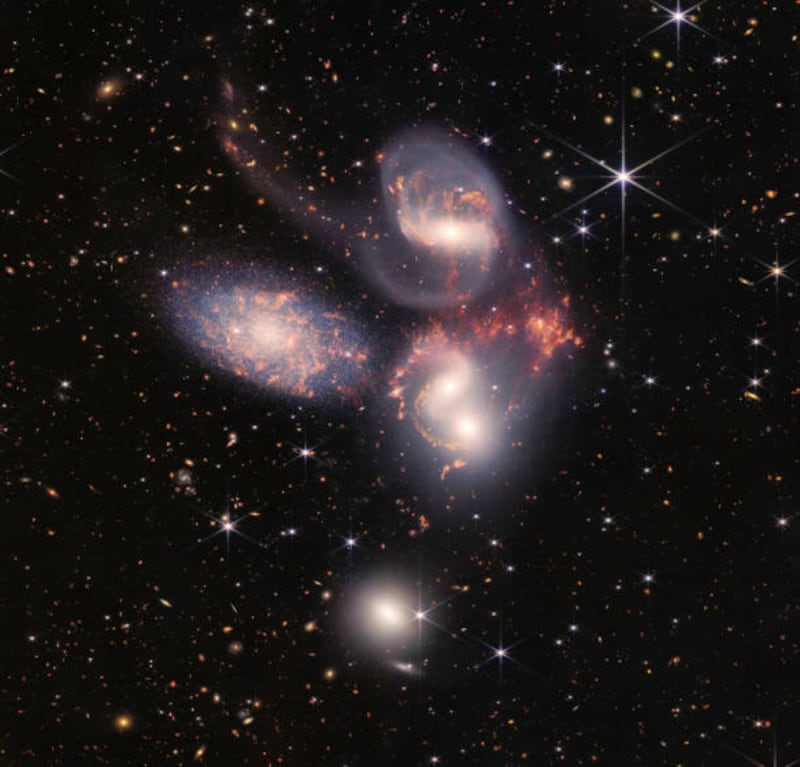The largest and most powerful telescope ever sent into space has within six months of launch revealed stunning images from the outer universe including an exploded star, a stellar nursery and an alien planet.
The James Webb Space Telescope has also provided remarkable visual insights into the birth of the universe more than 13 billion years ago. The images are in exquisite detail – the first batch released on Tuesday included one of five galaxies interacting in a cosmic dance.

They were shared by Nasa during a live broadcast in partnership with European Space Agency and the Canadian Space Agency. Dublin Institute of Advanced Studies livestreamed the event from Dunsink Observatory in Co Dublin to members of the public and the Irish science community, for it was in every sense a red letter day for Ireland’s burgeoning space sector.
Two of its astrophysicists, Prof Tom Ray and Dr Paddy Kavanagh, helped develop the mid-infrared instrument (MIRI) – one of four instruments on the telescope which is now moving in an orbit 1.5 million kilometres away from Earth.
READ MORE
“The telescope uses improved infrared technology to observe the universe, which allows it to see through dust and gas in ways other telescopes like the Hubble cannot,” Prof Ray explained.
A small Dublin-based company Réaltra Space Systems Engineering designed and manufactured the video imaging system onboard the Ariane 5 launch vehicle. Its impressive high-definition video images confirmed the successful separation of the launcher’s fairing and the telescope itself.
The size of a tennis court and three storeys high, the telescope successfully fully deployed its iconic 6.4-metre, gold-coated primary mirror on January 8th – another day when the hundreds of scientists involved had their fingers crossed anxiously. It then underwent testing to ensure its mirror alignment was correct.
The telescope is so precise and sensitive it will allow scientists to determine whether planets are habitable by looking at the chemical composition of their atmospheres, just one indication that a new era of space observation has begun that is poised to shape our understanding for decades to come.
“The Webb” has been designed to “look” back in time to the early universe. It performs this scientific miracle using infrared detectors which can pick up light that has been stretched, or “redshifted” to infrared wavelengths as it travels vast interstellar distance to reach us here.
“It works! This is our time machine,” declared John Mather, a senior astrophysicist at Nasa who was centrally involved in its development. The “time-travelling” aspect of the telescope is all to do with how long it takes light to travel through the universe.
“It is really fantastic...colleagues at Dias have been waiting 20 years for this,” Prof Ray added.
The MIRI with its infrared filters, which breaks up the light into its various components, was shipped off to Nasa almost seven years ago. Since then they have developed the software that analyses the instrument data sent back to Earth and produces the images.
Meanwhile, Dr Kavanagh is just back from the Webb Mission Operations Centre in Baltimore, US, where he was involved in testing and commissioning the technology over several months.
Both could not hide their joy at its performance after an exciting but nervous time getting the €10 billion instrument into place. The first image was the equivalent of photographing a grain of sand one metre away from the human eye, Prof Ray said. It was the taster, released in a ceremony at the White House on Monday; a rich cluster of galaxies known as SMACS 0723, which lies nearly 5 billion light years from Earth. The main meal that followed did not disappoint.
One image shows the formation of stars with jets of material travelling at supersonic speed away from them, while another is a dramatic picture of a dying star. An image of exoplanet WASP-96b indicated the presence of water in its atmosphere. “The cosmic cliffs of the Carina Nebula” shows for the first time hundreds of stars that were previously completely hidden from our view.
Payback for the Dias team is time to use the telescope. “It means we are involved. We’re not just looking at images. We’re not just sitting on the sidelines. We should be very proud as a country about that,” Dr Kavanagh said.













